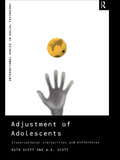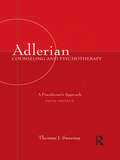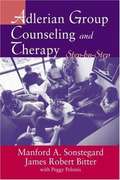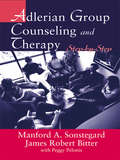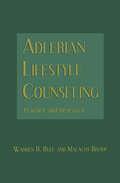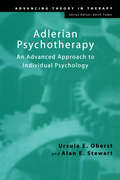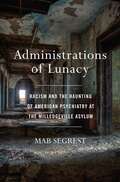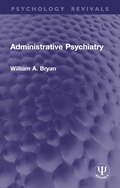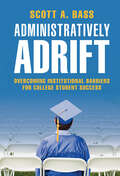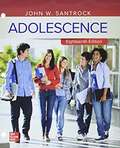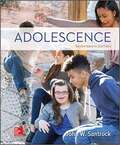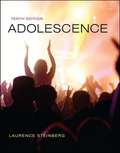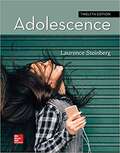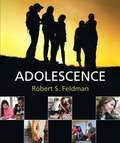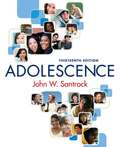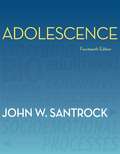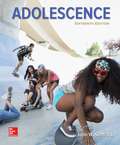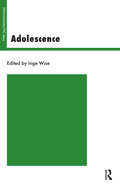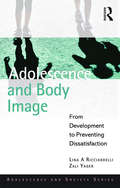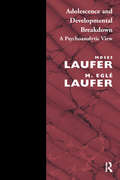- Table View
- List View
Adjustment of Adolescents: Cross-Cultural Similarities and Differences (International Series in Social Psychology)
by William Scott W. A. ScottThis book will make fascinating reading for anyone involved in the study of adolescence, or working with adolescents. The authors explore the transitions of school, family and personality in the contexts of family, friends and wider social factors. This exploration is based on original research carried out in Canberra, Winnipeg, Phoenix, Berlin, Hong Kong, Osaka and Taipei. The authors also provide valuable insights into the methodologies of cross-cultural study. The perspectives of this book make it an ideal resource for undergraduates and masters students undertaking a cross-cultural study, which is becoming a mandatory part of many degree courses.
Adjustment to Severe Physical Disability: A Metamorphosis
by Charlene Deloach Bobby G. Greer<p><i>Adjustment to Severe Physical Disability: A Metamorphosis</i>, then, is designed for professionals-in-training, practicing professionals, and parents or families of disabled persons. <p>The book deals with (1) the societal misconceptions that impede the physical, psychological, and social adjustment of disabled persons; (2) the effects these misconceptions have on the attitudes and effectiveness of those who work with disabled persons; and (3) existing services, laws, environmental changes, and technological advances that affect both the efforts of professionals and the lives of disabled persons. In keeping with the goals of this book, the content ranges from hard science to advocacy, from objective data to personal experiences. Case illustrations are designed to stimulate discussion and self-exploration, as well as to illuminate the factual basis for author opinions with no printed sources. Ideally, these illustrations will serve a heuristic function, leading students to conduct needed research into the psychosocial aspects of disability. </p>
Adlerian Counseling and Psychotherapy: A Practitioner's Approach, Fifth Edition
by Thomas J. SweeneyAdlerian Counseling and Psychotherapy, now in its fifth edition, remains a classic text for students and an essential resource for practitioner's of all levels of experience. Reviewers have consistently lauded the book in previous editions for its clarity, concise focus, and use of many practical applications. It explains and illustrates individual, group, and couples work with children, adolescents, and adults of all ages. It highlights Adler's and Dreikurs's unique contributions to child guidance, lifestyle assessment and early recollections, and why it has been rated the most multicultural appropriate theory among counseling approaches. The fifth edition presents a fresh organization and an even clearer structure. A new emphasis is placed on the distinction between counseling and psychotherapy, as practiced from the Adlerian perspective. Additional chapter activities and review questions are added throughout the text, and all previous material is updated and refreshed.
Adlerian Counseling and Psychotherapy: A Practitioner's Wellness Approach
by Thomas J. SweeneyAdlerian Counseling and Psychotherapy, now in its sixth edition, places a fresh emphasis on wellness both in concept and in practice. Written with the practitioner in mind, this text provides a definitive overview of the theory and practice of individual psychology based on the work of both Alfred Adler and Rudolf Dreikurs. The sixth edition retains the clarity, focus, and practicality of the previous editions and incorporates research, methods, and techniques to illustrate the usefulness of the Adlerian approach with children, adolescents, and adults of all ages in settings with individuals, groups, and couples. Parent education, career counseling, lifestyle assessment and counseling, and clinical diagnosis and psychotherapy are all discussed, as are applications for working with clients of different cultural and ethnic backgrounds and gender orientations. Neuroscience concepts and methods are described in case examples that illustrate their effectiveness across the lifespan. Readers will also find clinical examples from lifestyle assessment and family counseling meetings, as well as tables and figures that augment the activities and review questions included with each chapter.
Adlerian Group Counseling And Therapy: Step-by-step
by James Robert Bitter Manford A. Sonstegard Peggy Pelonis<P>Adlerian Group Counseling and Therapy: Step-by-Step represents a distillation of some of the most significant ideas pertaining to the group work of Alfred Adler and Rudolf Dreikurs. <P>Drs. Manford Sonstegard and James Bitter illustrate the development of a group from its formation to its final stage, giving readers a clear picture of what is important to accomplish at each stage of the group. <P>This book also addresses many practical dimensions of the Adlerian group process, including: forming a group relationship; creating a democratic and accepting climate; conducting psychological assessments; increasing the awareness and insight of group members; translating group insight into action; methods of re-education through encouragement; and building on personal strengths discovered within the group experience.
Adlerian Group Counseling and Therapy: Step-by-Step
by James Robert Bitter Manford A. Sonstegard Peggy PelonisAdlerian Group Counseling and Therapy: Step-by-Step represents a distillation of some of the most significant ideas pertaining to the group work of Alfred Adler and Rudolf Dreikurs. Drs. Manford Sonstegard and James Bitter illustrate the development of a group from its formation to its final stage, giving readers a clear picture of what is important to accomplish at each stage of the group. This book also addresses many practical dimensions of the Adlerian group process, including: forming a group relationship; creating a democratic and accepting climate; conducting psychological assessments; increasing the awareness and insight of group members; translating group insight into action; methods of re-education through encouragement; and building on personal strengths discovered within the group experience.
Adlerian Lifestyle Counseling: Practice and Research
by Malachy Bishop Warren R. RuleA rare balance of both practical application and empirical research investigation, Adlerian Lifestyle Counseling provides mental health practitioners with an invaluable resource on the theories of counseling pioneer Alfred Adler. Warren R. Rule and Malachy Bishop, both reputed authorities on rehabilitation counseling and Adlerian theory, present useful practitioner consideration and applications, preparing the reader for a wide variety of counseling situations. Research studies also included in this volume - on topics scanning career choice, parental behavior, personal characteristics, and more - ground these practices in a basic theoretical framework. Adlerian theory is a popular and powerful approach that respects the uniqueness and creative potential of the individual. This comprehensive collection on the topic is a significant addition to the counseling research canon.
Adlerian Psychotherapy: An Advanced Approach to Individual Psychology (Advancing Theory in Therapy)
by Ursula E. Oberst Alan E. StewartAdlerian Psychotherapy gives an account of Adlerian therapy and counselling from its origins to the present day, and proposes an advanced version of the theory. The main principles and concepts of Adler's thinking are re-examined from a contemporary perspective, placing them in the context of other contemporary approaches. Adler's techniques are described then applied to an understanding of what an Adlerian approach to family life would look like, using clinical examples throughout. The authors analyse the possible contribution of Adlerian theory in the context of the challenges of postmodern thought and postmodern society. It will be invaluable to professionals, practitioners and students of counselling and psychotherapy.
Administrations Of Lunacy: Racism And The Haunting Of American Psychiatry At The Milledgeville Asylum
by Mab SegrestA scathing and original look at the racist origins of psychiatry, through the story of the largest mental institution in the world Today, 90 percent of psychiatric beds are located in jails and prisons across the United States, institutions that confine disproportionate numbers of African Americans. After more than a decade of research, the celebrated scholar and activist Mab Segrest locates the deep historical roots of this startling fact, turning her sights on a long-forgotten cauldron of racial ideology: the state mental asylum system in which psychiatry was born and whose influences extend into our troubled present. In December 1841, the Georgia State Lunatic, Idiot, and Epileptic Asylum was founded. A hundred years later, it had become the largest insane asylum in the world with over ten thousand patients. Administrations of Lunacy tells the story of this iconic and infamous southern institution, a history that was all but erased from popular memory and within the psychiatric profession. Through riveting accounts of historical characters, Segrest reveals how modern psychiatric practice was forged in the traumas of slavery, the Civil War, Reconstruction, and Jim Crow. Deftly connecting this history to the modern era, Segrest then shows how a single asylum helped set the stage for the eugenics theories of the twentieth century and the persistent racial ideologies of our own times. She also traces the connections to today’s dissident psychiatric practices that offer sanity and create justice. A landmark of scholarship, Administrations of Lunacy restores a vital thread between past and present, revealing the tangled racial roots of psychiatry in America.
Administrative Leaders and School Counselors: Building on Theories, Standards, and Experiences for Optimal Mental Health Collaboration
by Lisa A. Wines Judy A. Nelson Natalie FikacThis practice-based text offers a roadmap to optimal collaboration for all school leaders – including counselors, superintendents, principals, and university faculty – to provide the best mental health outcomes for students. Administrative Leaders and School Counselors is a timely publication that creatively and cohesively authenticates the relationship between administrative leaders and school counselors. In order to systemically promote mental health consciousness and considerations for school counselors as practitioners and in training, collaboration among school leaders is essential for comprehensive school counseling programs, practices, funding, partnerships, and services designed for students. The first to feature perspectives from a diverse set of leadership positions in schools, the book provides individuals with exposure to educational leadership models and decisions that impact the roles of school counselors. The book will appeal to faculty who are teaching and training those who are or will ultimately be working as professional school counselors, counseling psychologists, or educational leaders such as principals, directors, department chairs, and superintendents.
Administrative Psychiatry (Psychology Revivals)
by William A. BryanOriginally published in 1937, Administrative Psychiatry was the first book to present theory and practice in a hospital for psychiatric patients. Every detail of the organization and direction of a psychiatric hospital is described in this volume. Everything advocated in this volume had passed the test of actual trial, the principles set forth having been in continuous operation over a period of years before the book was written. A pioneering text at the time, today it can be read in its historical context.This book is a re-issue originally published in 1937. The language used is a reflection of its era and no offence is meant by the Publishers to any reader by this re-publication.
Administratively Adrift: Overcoming Institutional Barriers for College Student Success
by Scott A. BassThe multiple crises of 2020–21 have presented both challenges and opportunities for change in four-year residential colleges and universities. Evidence indicates that the historic structure of administrative and student services is increasingly mismatched to the needs of a diverse and stressed student body born in a digital age. Inspired by his leadership in a university-wide initiative that focused on how students' interactions with both academic and professional staff affect their success and well-being, Scott A. Bass presents fresh insights on the inner workings of traditional nonprofit four-year degree residential institutions. The book describes the influences of history, tradition, and internal and external pressures on the American university, highlighting its evolution to its staid and fragmented structure; it distills voices of students, faculty, and staff; and it explores how successful organizations outside of higher education deliver services, with potential applicability for the academy's ability to meet students where they are.
Admirable Evasions
by Theodore DalrympleIn Admirable Evasions, Theodore Dalrymple explains why human self-understanding has not been bettered by the false promises of the different schools of psychological thought. Most psychological explanations of human behavior are not only ludicrously inadequate oversimplifications, argues Dalrymple, they are socially harmful in that they allow those who believe in them to evade personal responsibility for their actions and to put the blame on a multitude of scapegoats: on their childhood, their genes, their neurochemistry, even on evolutionary pressures.Dalrymple reveals how the fashionable schools of psychoanalysis, behaviorism, modern neuroscience, and evolutionary psychology all prevent the kind of honest self-examination that is necessary to the formation of human character. Instead, they promote self-obsession without self-examination, and the gross overuse of medicines that affect the mind.Admirable Evasions also considers metaphysical objections to the assumptions of psychology, and suggests that literature is a far more illuminating window into the human condition than psychology could ever hope to be.
Adolescence
by John SantrockAs a master teacher, John Santrock connects current research with real-world application, helping students see how developmental psychology plays a role in their own lives and future careers. Through an integrated learning goals system, this comprehensive approach to adolescent development helps students gain the insight they need to study smarter, stay focused, and improve performance.
Adolescence
by John W. SantrockAs a master teacher, John Santrock connects current research with real-world application, helping students see how developmental psychology plays a role in their own lives and future careers. Through an integrated learning goals system, this comprehensive approach to adolescent development helps students gain the insight they need to study smarter, stay focused, and improve performance.
Adolescence
by Laurence SteinbergIn this tenth edition of Adolescence, Laurence Steinberg continues to utilize an effective combination of a friendly writing style, thorough research, and a contextual approach that emphasizes adolescence in contemporary society. The text's careful organization ensures maximum teaching flexibility that allows the chapters to work together to be covered in sequence or to stand alone. Ethnicity and minority issues are thoroughly discussed in a way that enables students to see how the adolescent experience is shaped by class and culture. The strong pedagogical framework helps students organize and integrate material. Thoroughly updated to reflect current findings in the field of adolescent development, Adolescence is based on solid research and theory, yet it has a distinctively "real world" feel that emphasizes the reality of being an adolescent in today's society.
Adolescence
by Laurence SteinbergCutting-edge science, personalized for today’s students. <p><p> As a well-respected researcher, Laurence Steinberg connects current research with real-world application, helping students see the similarities and differences in adolescent development across different social, economic, and cultural backgrounds. <p><p> Through an integrated, personalized digital learning program, students gain the insight they need to study smarter, stay focused, and improve their performance.
Adolescence
by Robert S. FeldmanThe book is intended to excite readers about the field of adolescence, draw them into its way of looking at the world, and to shape their understanding of the significant developmental issues that characterize this period. Designed to capture the physical, cognitive, social, and personality development as individuals move from childhood into adulthood, 'Adolescence' provides an accurate, broad, and comprehensive introduction to the field of adolescent development.
Adolescence (13th edition)
by John W. SantrockThe new edition includes substantially expanded material on diversity and culture, adolescents and emerging adults health and well-being, including numerous recommendations for improving the lives of adolescents.
Adolescence (Fourteenth Edition)
by John W. SantrockMore students learn from John Santrock’s Adolescence than from any other text in this field. The 14th edition combines proven pedagogy and the most current research to provide a market leading presentation of adolescence. This time tested text provides compelling contemporary research, including updates from eleven leading experts in the field. The text's accessible presentation, plentiful applications and engaging writing foster increased mastery of the content. The new edition includes substantially expanded material on diversity and culture, adolescents’ and emerging adults’ health and well-being, including numerous recommendations for improving the lives of adolescents, and expanded emphasis on the positive aspects of adolescent development.
Adolescence (Sixteenth Edition)
by John W. SantrockConnecting research and results. As a master teacher, John Santrock connects students to current research and real-world application, helping students see how adolescent psychology plays a role in their own lives and future careers. Through an integrated, personalized digital learning program, students gain the insight they need to study smarter and improve performance.
Adolescence (The\psychoanalytic Ideas Ser. #Vol. 3)
by Inge Wise'Adolescence - when we are no longer children and have not yet reached adulthood - is a time of much disturbance, change and potential for growth. The adolescent is confronted with a body that stretches, changes and grows in all directions, as does her or his mind: he is no longer who he was.'- Inge Wise from her Introduction Adolescence is a turbulent period of time in life. Adolescents experience hormonal and physical changes that affect their mood and emotions. Psychoanalysis can help them resolve these new and often confusing feelings.In this collection, Inge Wise has gathered together a wide range of papers, dealing with issues such as adolescent violence, suicidal feelings, and addiction. Other papers explore psychoanalytic definitions of adolescence and central psychoanalytic contributions to the understanding of adolescence.
Adolescence and Body Image: From Development to Preventing Dissatisfaction (Adolescence and Society)
by Lina A Ricciardelli Zali YagerBody image is a significant issue for the majority of adolescents. Anxieties relating to body image can be crippling across both genders, their debilitating effects sometimes leading to mental health problems. This important book is the first of its kind to focus specifically on adolescents, providing a comprehensive overview of the biological, psychological and socio-cultural factors relating to the development of body image. It also provides a detailed review of the measures which can be taken to address body dissatisfaction. Discussing the role of culture, family, peers, schools, sport and media in stimulating a negative body image, the book also examines the different challenges faced by girls and boys as they grow. Eating disorders and body change strategies are also addressed, as well as the challenges faced by youngsters affected by conditions causing visible differences, such as hair loss in cancer patients.The book also presents original research, including the results from a large Australian study of the body image and associated health behaviours of adolescent boys, and the results of a study of current teaching practices relating to body image. Adolescence and Body Image will be ideal reading for students and researchers from a variety of fields, including developmental, health, and social psychology, sociology, and cultural and health studies. Professionals working with young people, whether in education, health promotion or any other allied discipline will also find this book an invaluable resource.
Adolescence and Breakdown (Routledge Library Editions: Adolescence #6)
by Simon MeyersonIn this volume and its companion Adolescence: The Crises of Adjustment, originally published in 1975, members of the Adolescent Department at the Tavistock Clinic and of the Tavistock Institute of Human Relations, together with other leading experts on the subject, present a unique study of adolescence. Of all living species only human beings go through a period of adolescence – and because the conflicting influences that adolescents encounter both within themselves and in the outside world are so complex, even normal adolescence is a time of crises and adjustment. While Adolescence: The Crises of Adjustment is devoted to the dynamics and complexities of ‘normal adolescence’, the present volume traces what happens when the crises of adolescence are not sufficiently well negotiated. The topics debated and explored include: emotional conflicts; educational drop-outs; social conflict; delinquency; acting-out, rebellion and violence; drugs; depression and suicide; individual treatment; family therapy.
Adolescence and Developmental Breakdown: A Psychoanalytic View
by Moses Laufer M.Egle LauferIn this book, Moses and Egle Laufer contend that severely disturbed adolescents can be assessed and treated psychoanalytically, and that their illness differs from comparable in older patients, and that the psychopathology has its source in conflicts over the sexually mature body. Extensive case histories support their argument.
